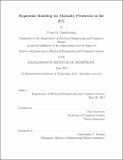| dc.contributor.advisor | Peter Szolovits. | en_US |
| dc.contributor.author | Sundaresan, Tejas G | en_US |
| dc.contributor.other | Massachusetts Institute of Technology. Department of Electrical Engineering and Computer Science. | en_US |
| dc.date.accessioned | 2018-01-12T20:56:03Z | |
| dc.date.available | 2018-01-12T20:56:03Z | |
| dc.date.copyright | 2017 | en_US |
| dc.date.issued | 2017 | en_US |
| dc.identifier.uri | http://hdl.handle.net/1721.1/113105 | |
| dc.description | Thesis: M. Eng., Massachusetts Institute of Technology, Department of Electrical Engineering and Computer Science, 2017. | en_US |
| dc.description | This electronic version was submitted by the student author. The certified thesis is available in the Institute Archives and Special Collections. | en_US |
| dc.description | Cataloged from student-submitted PDF version of thesis. | en_US |
| dc.description | Includes bibliographical references (pages 85-89). | en_US |
| dc.description.abstract | Severity of illness scores are commonly used in critical care medicine to guide treatment decisions and benchmark the quality of medical care. These scores operate in part by predicting patient mortality in the ICU using physiological variables including lab values, vital signs, and admission information. However, existing evidence suggests that current mortality predictors are less performant on patients who have an especially high risk of mortality in the ICU. This thesis seeks to reconcile this difference by developing a custom high risk mortality predictor for high risk patients in a process termed sequential modeling. Starting with a base set of features derived from the APACHE IV score, this thesis details the engineering of more complex features tailored to the high risk prediction task and development of a logistic regression model trained on the Philips eICU-CRD dataset. This high risk model is shown to be more performant than a baseline severity of illness score, APACHE IV, on the high risk subpopulation. Moreover, a combination of the baseline severity of illness score and the high risk model is shown to be better calibrated and more performant on patients of all risk types. Lastly, I show that this secondary customization approach has useful applications not only in the general population, but in specific patient subpopulations as well. This thesis thus offers a new perspective and strategy for mortality prediction in the ICU, and when taken in context with the increasing digitization of patient medical records, offers a more personalized predictive model in the ICU. | en_US |
| dc.description.statementofresponsibility | by Tejas G. Sundaresan. | en_US |
| dc.format.extent | 107 pages | en_US |
| dc.language.iso | eng | en_US |
| dc.publisher | Massachusetts Institute of Technology | en_US |
| dc.rights | MIT theses are protected by copyright. They may be viewed, downloaded, or printed from this source but further reproduction or distribution in any format is prohibited without written permission. | en_US |
| dc.rights.uri | http://dspace.mit.edu/handle/1721.1/7582 | en_US |
| dc.subject | Electrical Engineering and Computer Science. | en_US |
| dc.title | Sequential modeling for mortality prediction in the ICU | en_US |
| dc.type | Thesis | en_US |
| dc.description.degree | M. Eng. | en_US |
| dc.contributor.department | Massachusetts Institute of Technology. Department of Electrical Engineering and Computer Science | |
| dc.identifier.oclc | 1016164407 | en_US |
